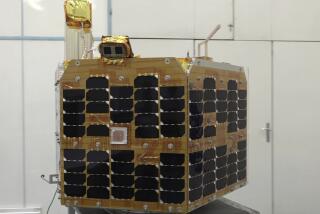31-Yr. Era Ends With Launch of Cape Rocket
- Share via
CAPE CANAVERAL, Fla. — After more than 400 liftoffs, NASA launched its last unmanned space rocket from this spaceport today, propelling a $125-million Navy communications satellite into orbit.
A 31-year era ended when an Atlas-Centaur rocket blazed away from the pad at 4:56 a.m. and hoisted a 5,100-pound payload intended to link land, sea and air forces around the globe with the Joint Chiefs of Staff, the National Command Authority and the President’s military command network.
Lightning in the area held up the launch for 44 minutes, and the Atlas-Centaur lifted off with just one minute remaining in a favorable 45-minute launch period.
Today’s launch was delayed more than two years because of a 1987 launch pad accident that severely damaged the rocket’s Centaur stage.
One Rocket Left
The space agency has one unmanned rocket left--a Delta that is to loft a scientific satellite from Vandenberg Air Force Base, Calif., in November.
But today’s flight is the last from Cape Canaveral, where the National Aeronautics and Space Administration got its start and where it has launched nearly all its rockets.
“It’s always sad to see the end of an era,” said James L. Womack, NASA’s director of expendable launch vehicles.
“There’s a certain element of sadness, but the things we have done have been fabulous,” said Joseph Mahon, the agency’s assistant administrator for space flight.
With the launch, NASA’s only remaining launch vehicle here is the manned space shuttle.
More to Read
Sign up for Essential California
The most important California stories and recommendations in your inbox every morning.
You may occasionally receive promotional content from the Los Angeles Times.










